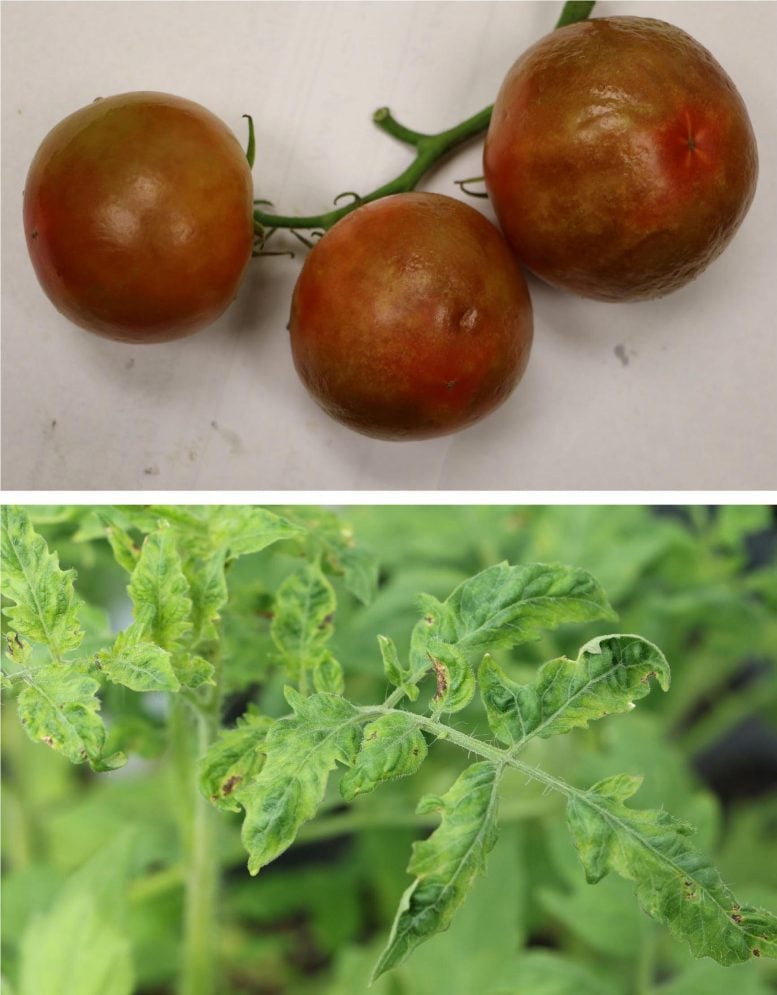
Temperature shapes tomato resistance. New cultivars could help growers worldwide.
Scientists from the USDA’s Agricultural Research Service (ARS), working with university collaborators, are helping American tomato growers confront a serious plant disease. They discovered that a tomato line developed three decades ago shows promising resistance to the tomato brown rugose fruit virus (ToBRFV), an emerging threat capable of inflicting billions of dollars in losses on the tomato industry in the United States and worldwide.
ToBRFV attacks tomatoes, peppers, and related crops by causing leaf distortion and fruit discoloration, which significantly reduces yields. The virus is transmitted through seed and can bypass the resistance genes present in today’s commercial tomato varieties.
It spreads easily when healthy plants come into contact with contaminated tools, clothing, hands, or infected plant material. For growers, the most reliable defense remains strict prevention, which includes disinfecting equipment, sanitizing facilities, and maintaining clean cultivation areas.
“To minimize the impact of ToBRFV, it is crucial to identify new sources of genetic resistance that can be used to breed virus-resistant tomato cultivars,” said Kai Ling, an ARS research plant pathologist at the U.S. Vegetable Laboratory in Charleston, SC. “While prevention is important, deploying cultivars with resistance genes is the critical strategy to combat tobamoviruses.”
The tomatoNN line and its history
A recent study published in Plant Biotechnology Journal reports that Ling and his team identified a tomato line (tomatoNN) developed in the 1990s that expresses the tobacco N gene and shows resistance to ToBRFV. This line was originally created by ARS plant molecular geneticist Barbara Baker and her colleagues at the Plant Gene Expression Center in Albany, CA.

Baker’s group had isolated the N gene from a wild tobacco relative, where it provides resistance to the tobacco mosaic virus (TMV), and then used it to produce the TMV-resistant tomatoNN line.
Ling and his colleagues discovered that the tomatoNN line is resistant to ToBRFV at 22°C (71.6°F), but the resistance decreases at higher temperatures, such as 30°C (86°F), which is characteristic of several resistance genes, including N-mediated TMV resistance.
Temperature as a key factor
“As we look at the possible virus-resistant tomato cultivars, it is important to understand the role that temperature plays in production,” said Ling. “Temperature is a significant environmental cue that greatly influences host-pathogen interactions. Further study is needed to identify the role of temperature in the genetic resistance to tomatoNN.”
The study’s findings bring researchers one step closer to controlling ToBRFV.
“The results described in this paper highlight the significant potential of using the tomatoNN line to breed tomato cultivars resistant to ToBRFV and offer a new approach to managing this important disease for a beloved food staple,” said Ling.
Reference: “The N gene protects tomato plants from tomato brown rugose fruit virus infection” by Jing Zhou, Andrea Gilliard, Jeffrey Tung, Savithramma P. Dinesh-Kumar, Steven A. Whitham, Barbara Baker and Kai-Shu Ling, 2 July 2025, Plant Biotechnology Journal.
DOI: 10.1111/pbi.70237
Never miss a breakthrough: Join the SciTechDaily newsletter.
1 Comment
Fascinating work by the USDA team! It’s incredible to see how a tomato line developed in the 1990s could hold the key to protecting today’s crops from ToBRFV. This shows the value of preserving plant genetic diversity and highlights the importance of integrating resistant cultivars into modern agriculture. At Xiphias Superfoods, we’re always inspired by research that strengthens our food supply while promoting sustainable farming practices. Excited to see how these findings could shape virus-resistant tomatoes for the future!